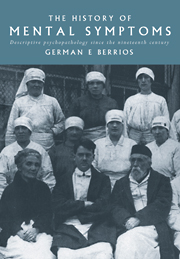Book contents
CHAPTER 18 - Personality and its disorders
from PART V - Miscellany
Published online by Cambridge University Press: 08 January 2010
Summary
Words and concepts related to aspects of behaviour now addressed as ‘personality’ (or disorders of) have been known for millenia. The historian must identify the moment when such descriptions appeared and the scientific and social forces that made them possible. Subordinate questions concern the conceptual pedigree of ‘personality trait’ as it is important to know whether it is different from that of ‘symptom’. Likewise, it is important to understand why ‘type’ and ‘trait’ have taken turns as the units of clinical analysis for personality disorder. Other questions might also be answered from the historical perspective: What is the relationship between ‘trait’ and ‘dimension’? Has the old notion of ‘moral insanity’ anything to do with the more recent one of ‘psychopathic behaviour’? Is the latter best conceived as a disorder of personality or as a form of insanity? Should the ‘neuroses’ be considered as periodic forms of personality disorder? What is the relationship between psychoses and disorder of personality? When did the concept of psychopathic personality become contaminated by ‘moral’ nuances? Are terms currently favoured any better than older ones such as moral insanity, impulsion, impulsive insanity, lucid insanity, volitional insanity, psychopathy, monomania, non-delusional insanity, or reasoning insanity? This chapter will focus on the nineteenth century and after. Historical scholarship on this period is beginning to accumulate.
The nineteenth century intellectual background
As repeatedly mentioned in this book, there were two psychological theories during the nineteenth century. Faculty psychology (the oldest) conceived the mind as a set of powers, faculties or functions; the most popular being a tripartite division into intellectual (cognitive), emotional (orectic), and volitional (or conative).
- Type
- Chapter
- Information
- The History of Mental SymptomsDescriptive Psychopathology since the Nineteenth Century, pp. 419 - 442Publisher: Cambridge University PressPrint publication year: 1996
- 4
- Cited by



